size-of-ensemble
Elgar – Salut d’Amour – Alto Flute & Piano
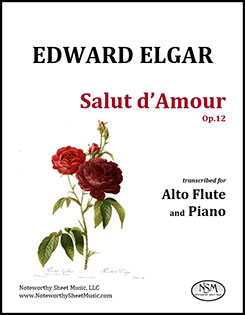 Salut d’Amour, Op. 12, by Edward Elgar
Salut d’Amour, Op. 12, by Edward Elgar
Transcribed for Alto Flute and Piano by C. A. Vater
Piano Score and Part for Alto Flute, PDF $6.99
The English composer Edward Elgar held many positions throughout his career, including those of organist at St. George’s Roman Catholic Church in Worcester, conductor of the Worcester Philharmonic, Professor of Music at the University of Birmingham, and conductor of the London Symphony Orchestra. He achieved considerable prominence as a result of his many successful orchestral, vocal, and chamber music compositions. Elgar composed this piece in 1888, as an engagement gift to his beloved future wife. Though first written for piano solo, arrangements were created shortly thereafter by the composer himself for violin and piano, and for orchestra. Originally titled “Liebesgruss” (Love’s Greeting), but later changed to Salut d’Amour, the piece is now one of Elgar’s most widely recognized works, and its immense popularity has led to arrangements for a wide variety of other instruments. We provide here a transcription of Salut d’Amour for alto flute and piano, which has been adapted from the editions published by Schott for violin and piano, oboe and piano, or orchestra and which are now in the public domain.
Score, 4 pages; Alto Flute part, 2 pages; Total, 10 pages.
PreviewFalla - Siete Canciones populares Españolas - Alto Flute (& piano)
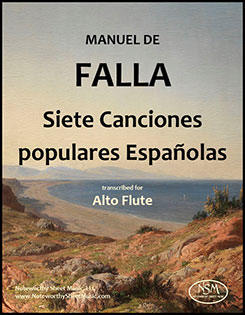 Seven Spanish Folksongs, by Manuel de Falla
Seven Spanish Folksongs, by Manuel de Falla
Transcribed for Alto Flute (and piano) by C. A. Vater
Alto Flute part, PDF $8.99
The seven songs included in the original voice and piano publication, as well as in our alto flute part edition, are El Paño Moruno (“The Moorish Cloth”), Seguidilla murciana (an old dance form, omitted in the Kochánski violin and piano version), Asturiana (a lament from the northern part of Spain), Jota (a familiar dance form from the north east of Spain), Nana (an Andalusian lullaby), Canción (“Song”), and Polo (reminiscent of the zapateado, a Spanish dance rich in flamenco rhythms). This information and an in-depth analysis of the Siete canciones populares españolas, including historical and regional background, music analysis, and an English translation of the lyrics, can be found in the excellent article by composer and conductor Gianmaria Griglio, co-founder and Artistic Director of ARTax Music.
Alto Flute part, 8 pages; Total,10 pages. (pdf of piano accompaniment is freely available at imslp.org)
PreviewFarrenc – Trio, Op.45 – Viola
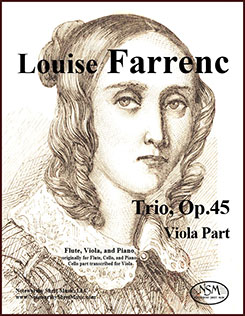 Trio, Op.45, by Louise Farrenc
Trio, Op.45, by Louise Farrenc
Transcribed for Viola by C.A.Vater and J.W.Pratt (originally for cello)
Viola Part, PDF $9.99
The Farrenc Trio for Flute, Cello, and Piano, Op.45 is a big romantic piece, at times stirring, sweet, stormy, sad, dramatic, or lively, but always compelling throughout its entire four movements. As a flutist, I have enjoyed playing this piece many times, so I was intrigued and delighted to receive a request from flutist Peter H. Bloom that NSM prepare a transcription of the cello part for viola, so that his group Ensemble Aubade could perform a flute/viola/piano version. As Peter Bloom commented, the Trio is “not just a good piece to have been written by a woman in the 19th century; it’s a very good piece for anyone to have written anytime.” The Trio actually feels perfect for the viola, as most of the original cello part lies within viola range, and sections that do not can be modified for the viola tessitura without straying significantly from the composer’s musical intent. Our edition provides only the transcribed viola part; PDFs of the original score and flute part are freely available at imslp.org. —cav
Viola Part, 12 pages; Total, 16 pages.
PreviewFauré - Berceuse - Alto Flute & Piano
Berceuse, Op.16, by Gabriel Fauré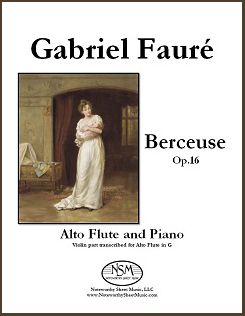
Transcribed for Alto Flute and Piano by C.A.Vater
Piano Score and Alto Flute Part, PDF $6.99
Gabriel Fauré composed his Berceuse (Op. 16) for violin (or cello) and piano in 1878-1879, and it was first published by J. Hamelle, Paris. To this day, the Berceuse remains one of Fauré's most beloved and popular works. The piece is simple but beautiful, short, with a quiet sweet melody that appeals to both performers and audiences alike. It is no wonder that over the years the Berceuse has been transcribed for many other instruments; arrangements have been created for solo piano, viola, flute, alto saxophone, flute and harp, and string quartet, in addition to the composer's own arrangement for violin and orchestra.
Now, in response to an excellent suggestion we received from one of our customers, we add our own version of the Fauré Berceuse, a transcription for alto flute and piano. Perhaps we are biased, but we think the alto flute is a wonderful instrument choice for this lullaby. The piece is suitable for players of all levels.
Alto Flute part, 2 pages; Piano Score, 5 pages; Total, 12 pages.
PreviewFauré - Pièce - Alto Flute & Piano
 Pièce (Vocalise-Étude), by Gabriel Fauré
Pièce (Vocalise-Étude), by Gabriel Fauré
Transcribed for Alto Flute and Piano by C.A.Vater
Alto Flute Part and Piano Score, PDF $4.99
Vocalises are songs without words written to provide technical challenges for singers; they are designed to develop flexibility and control, and thus often serve as vocal warm-up exercises. Gabriel Fauré composed his Vocalise-Étude in 1906, and it was published by Leduc the following year. The original piece, in the key of E minor and marked Adagio molto tranquillo, includes a piano accompaniment and incorporates various difficulties for the vocal soloist, including wide intervals, unexpected harmonies, and demanding rhythms.
Fauré's Vocalise-Étude has long been recognized as a particularly lovely and poignant piece of music, not merely a vocal exercise but a musical work of intrinsic beauty. Under its alternative name Pièce, the Vocalise-Étude has been transcribed for various orchestral instruments, including bassoon and piano, flute and piano, and oboe and harp. We at Noteworthy Sheet Music think the alto flute, with its rich, mellow tone, is the perfect instrument for this moving and somewhat melancholy Fauré melody. Our transcription for alto flute and piano is based on the version of the Vocalise-Étude for medium voice, in the key of D minor, published by Alphonse Leduc in 1907 and now in the public domain.
Alto Flute part, 1 page; Piano Score, 3 pages; Total, 8 pages.
PreviewFauré - Sicilienne - Alto Flute
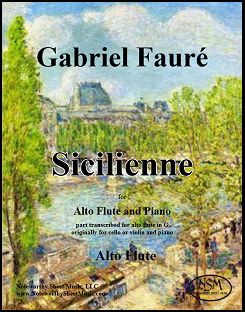 Sicilienne, Op.78, by Gabriel Fauré
Sicilienne, Op.78, by Gabriel Fauré
Transcribed for Alto Flute (and Piano) by C.A.Vater
Alto Flute Part, PDF $3.79
Sicilienne (Opus 78) was composed by Gabriel Fauré in 1893 and first published as a chamber music version for solo cello or violin with piano accompaniment in 1898. Numerous transcriptions of this popular piece have been made, including arrangements for flute and piano, viola and piano, horn and piano, flute and harp, 2 flutes and piano, flute and clarinet, and piano solo, among others. Our alto flute part is a transcription based on the original violin and cello parts of the edition published by J. Hamelle in 1898. We provide only the transcribed alto flute part; the piano accompaniment is readily available as a free pdf download of the original score for piano and cello, now in the public domain.
Alto Flute part, 2 pages of music; Total, 4 pages.
Figueiredo - Na Rua Dos Meus Ciúmes - WW5
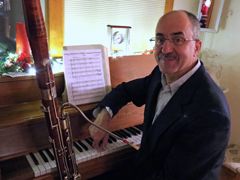 Na Rua dos Meus Ciúmes, Traditional Fado
Na Rua dos Meus Ciúmes, Traditional Fado
Arranged for Woodwind Quintet by Antonio F. Figueiredo
Parts and Score, PDF $10.00
Na Rua Dos Meus Ciúmes is a traditional Portugese fado, still highly popular among recording artists today. This passionate love song tells the story of the intense jealousy experienced by a girl upon seeing her lover pass by with another woman on the street near her home. Though her pain is palpable, the girl is proud and determined to endure her suffering resolutely and without tears.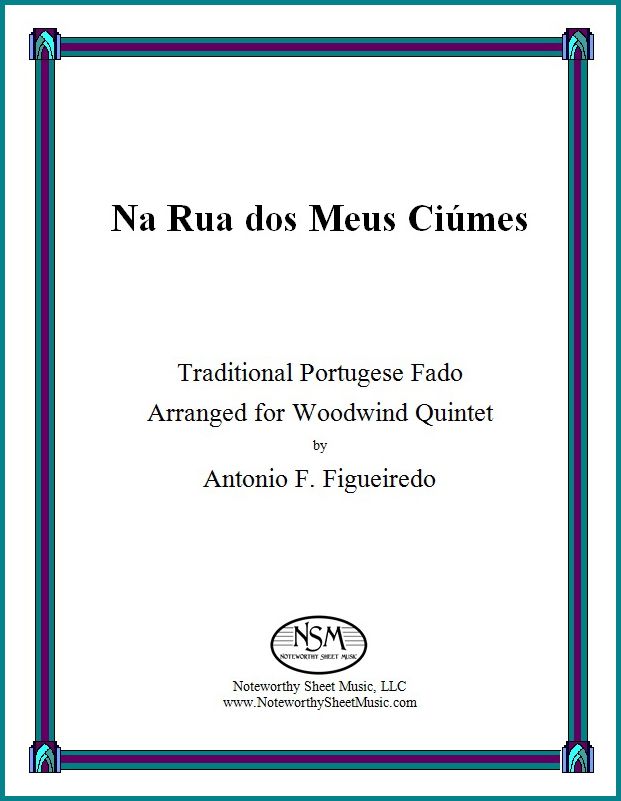
Antonio Figueiredo was born in the Azores, Portugal, and now resides in Massachusetts. He grew up listening to (and falling in love with) fado music, with all its romance and passion, and its timeless themes of love, loss, jealousy, poverty, and the sea. Figueiredo is a bassoonist who plays regularly in various orchestras and chamber music groups in the Boston area. He enjoys arranging folk tunes for woodwind quintet, and he created this delightful and engaging arrangement of Na Rua Dos Meus Ciúmes for one of his own groups. The piece is scored for flute, oboe, clarinet in B-flat, horn in F, and bassoon.
"This brief piece is a charming addition to the quintet repertory." Read John Ranck's full review of Figueiredo's arrangement of Na Rua Dos Meus Ciúmes.
Score, 5 pages; Parts, 1 page each; Total, 12 pages.
PreviewFinlayson - 3 Pagan Dances - Percussion Ensemble
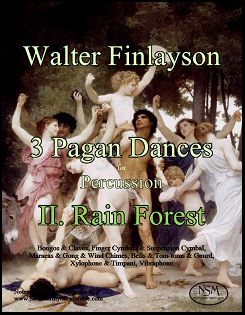 3 Pagan Dances, by Walter A. Finlayson
3 Pagan Dances, by Walter A. Finlayson
Contemporary Compositions for Percussion Ensemble
I. Goddess of the Earth: Score and Parts, PDF $8.99
II. Rain Forest: Score and Parts, PDF $6.99
III. Temple of the Sun: Score and Parts, PDF $13.99
Noteworthy Sheet Music's chief editorial consultant Peter H. Bloom received Walter Finlayson's previously-unpublished score for 3 Pagan Dances from the composer's daughter, and we were delighted for the opportunity to become acquainted with this rousing, intoxicating work. For our publications, we've opted to create separate editions for the three pieces, giving players the choice of acquiring only one or two of the 3 Pagan Dances at a time, depending on their level of interest and performance needs. In each case we have maintained the composer's allocation of instruments per player. Pagan Dance I. Goddess of the Earth is scored for (1) snare drum/suspension cymbal/gong, (2) tom-toms, (3) temple blocks/xylophone/cowbell, (4) bells, (5) chimes, and (6) timpani. Pagan Dance II. Rain Forest is scored for (1) bongos/claves, (2) finger cymbals/suspension cymbal, (3) maracas/gong/wind chimes, (4) bells/tom-toms/gourd, (5) xylophone/timpani, and (6) vibraphone. Pagan Dance III. Temple of the Sun is scored for (1) xylophone, (2) tom-toms, (3) temple blocks, (4) gong/suspension cymbal, (5) chimes/crash cymbal, and (6) timpani. Our editions of the 3 Pagan Dances include both scores and parts.
Click on the MP3 icons below to listen to audio samples from a 1964 performance of the work:
I. Goddess of the Earth audio ![]()
![]() II. Rain Forest
II. Rain Forest![]() III. Temple of the Sun
III. Temple of the Sun
We at NSM are pleased to aid in the re-discovery of some of Walter Finlayson's compositions; for additional biographical information about this remarkable composer, please visit the Our Composers page.
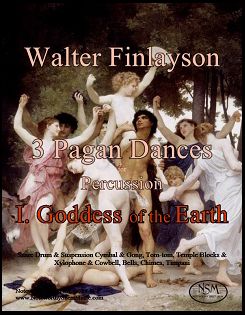 I. Goddess of the Earth: Score, 8 pages; Parts for (1) snare drum/suspension cymbal/gong, (2) tom-toms, (3) temple blocks/xylophone/cowbell, (4) bells, (5) chimes, and (6) timpani, 1 page each; Total, 16 pages
I. Goddess of the Earth: Score, 8 pages; Parts for (1) snare drum/suspension cymbal/gong, (2) tom-toms, (3) temple blocks/xylophone/cowbell, (4) bells, (5) chimes, and (6) timpani, 1 page each; Total, 16 pages
Preview I
 II. Rain Forest: Score, 6 pages; Parts for (1) bongos/claves, (2) finger cymbals/suspension cymbal, (3) maracas/gong/wind chimes, (4) bells/tom-toms/gourd, (5) xylophone/timpani, and (6) vibraphone, 1 page each; Total, 14 pages.
II. Rain Forest: Score, 6 pages; Parts for (1) bongos/claves, (2) finger cymbals/suspension cymbal, (3) maracas/gong/wind chimes, (4) bells/tom-toms/gourd, (5) xylophone/timpani, and (6) vibraphone, 1 page each; Total, 14 pages.
Preview II
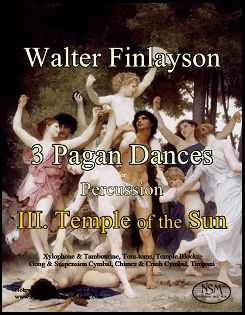 III. Temple of the Sun: Score, 13 pages; Parts for (1) xylophone, 2 pages, (2) tom-toms, 2 pages, (3) temple blocks, 2 pages, (4) gong/suspension cymbal, 1 page, (5) chimes/crash cymbal, 1 page, and (6) timpani, 2 pages; Total, 26 pages.
III. Temple of the Sun: Score, 13 pages; Parts for (1) xylophone, 2 pages, (2) tom-toms, 2 pages, (3) temple blocks, 2 pages, (4) gong/suspension cymbal, 1 page, (5) chimes/crash cymbal, 1 page, and (6) timpani, 2 pages; Total, 26 pages.
Preview III
Foster - Old Folks; Oh! Susanna - Vo/Pf/Fl/Vc
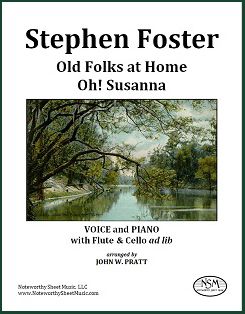 Old Folks at Home and Oh! Susanna, by Stephen Foster
Old Folks at Home and Oh! Susanna, by Stephen Foster
Arranged with Flute and Cello ad lib by John W. Pratt
Flute Parts, Cello Parts, Voice Parts, and Piano Scores ― PDF $7.99
The following excerpts are taken from John W. Pratt's foreword to the edition:When a Golden Oldie comes to mind, Doo-dah! Doo-dah!
Comic, sad, or any kind, Oh! Doo-dah-day!
Jeanie, Swanee, Kentucky, Joe, Doo-dah! Doo-dah!
Beautiful, dreamy, fast, or slow, Oh! Doo-dah-day!
I'll bet I know who wrote it, he wrote them night and day,
Stephen Foster wrote it, he'll never go away.
Stephen Foster was born in Lawrenceville, Pa., on July 4, 1826...He wrote over 200 songs, including 135 parlor songs, 28 minstrel songs, and 21 hymns and Sunday school songs. A remarkable number are memorable, as the ditty above will attest to anyone with anything like my background. One wonders why. The harmonies and rhythms are basic, as are the forms and rhyme schemes (see above), the music is repetitious, and the vocal range rarely goes outside an octave (a great benefit for community singing). Yet the fit is so natural and the pacing so well judged that the songs are ideally effective and diabolically catchy. Foster is perhaps, though on a different plane, the Mozart of his field...
For a pianist playing several stanzas at a sing-along, Foster's songs do become a little dull. But their very simplicity, repetitiousness, and familiarity abet variation as, again on a different plane, chorales serve Bach chorale preludes. Like chorale preludes, the piano parts here always incorporate the melody, so they can be played solo or to accompany amateur singers. It struck me that they could be enhanced by optional flute parts. After writing them, I discovered that, according to his brother Morrison, Foster himself "delighted in playing accompaniments on the flute...As the song went on he would improvise...the most beautiful variations upon its musical theme." If Foster's improvisations were like the one his brother published, however, they just varied the melody itself in the manner of the period. My game is more ambitious, as you will easily see. I added optional cello parts, mostly for color, as in the Haydn trios but superficially more interesting for the cellist. (Again we are on a different plane, of course.)
"Oh! Susanna," one of the best-known American songs by anybody, is Foster's "Erlkönig." (Speak of different planes!) With its nonsensical lyrics and polka beat, it is clearly comical, and I treated it accordingly. It was written in Cincinnati, possibly for a social club, first performed at an ice cream saloon in Pittsburgh in 1847, and published in 1848. When no American song had sold over 5,000 copies, it sold over 100,000. It earned Foster only $100, but its popularity led to a publisher's offer, convincing him to become a professional songwriter, America's first.
"Old Folks at Home" established Foster as a truly American composer. It was written in 1851 for a blackface troupe whose leader paid Foster about $15 to be credited for it. When almost finished, Foster asked his brother for "a good name of two syllables for a Southern river." He rejected Yazoo and Pedee, but was delighted with Swanee, a shortening of Suwanee, a small river in Florida which his brother found in an atlas. Though about a slave's nostalgia for home, I find its theme universal and melancholy and I resisted the temptation to jazz it up. Please try, at least, a slowish tempo.
― John W. Pratt, May 27, 2013 ©
Flute parts, 2 pages; Cello parts, 2 pages; Voice parts, 2 pages; Scores, 7 pages; Total, 18 pages.
PreviewFürstenau - Adagio et Rondo Brillant - Fl & Pf
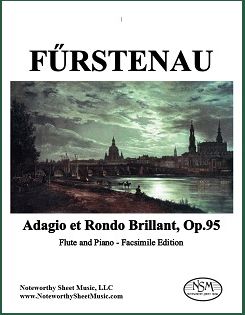 Adagio et Rondo Brillant, Op.95, by A. B. Fürstenau
Adagio et Rondo Brillant, Op.95, by A. B. Fürstenau
Gassett Collection - Facsimile Edition by C.A.Vater/Noteworthy Sheet Music with a Foreword by Peter H. Bloom
Flute Part and Piano Score, PDF $12.00
Anton Bernhard Fürstenau (1792-1852) was among the most revered flutists of the 19th century. Following his appointment to the post of principal flute for the Royal Chapel at Dresden in 1820, Fürstenau became a valued colleague and close personal friend of the court's music director, Carl Maria von Weber. The influence of Weber's dramatic melodic gestures and edgy harmonic shifts can be heard in this passionately evocative Adagio et Rondo Brillant. An NSM favorite!
For additional information about the Gassett Collection, please see see our article An Introduction to the Gassett Collection.
Piano score, 12 pages; Flute part, 4 pages; Total, 20 pages.
Preview